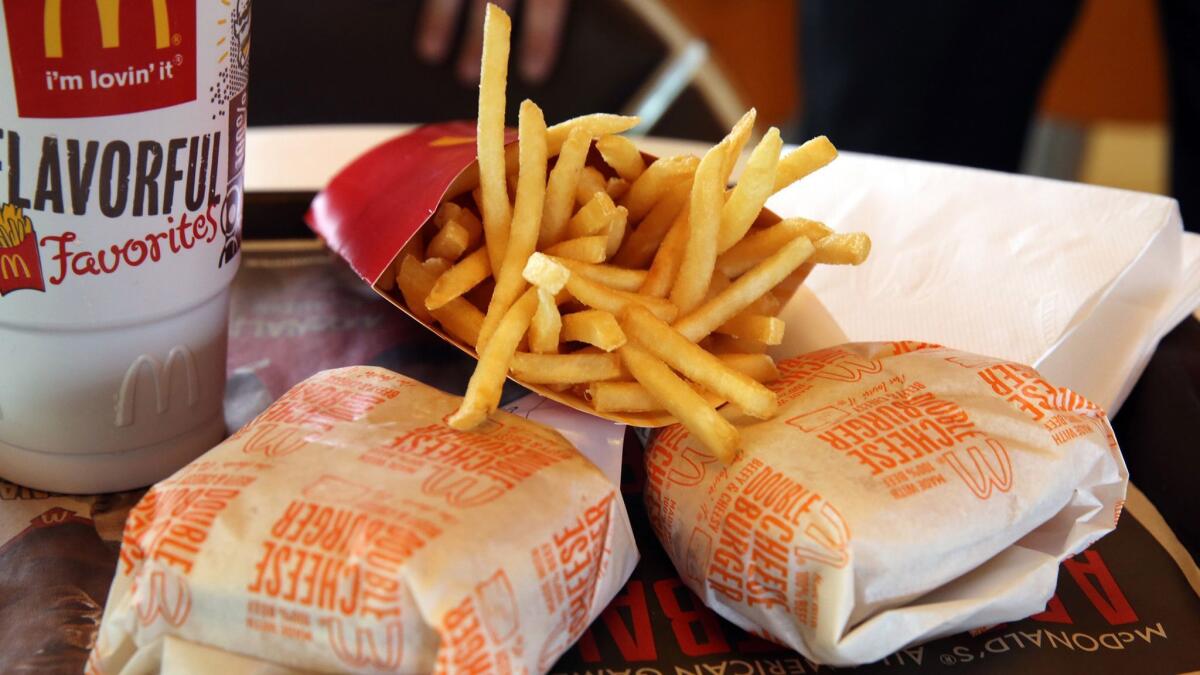American chain restaurants had a tough year. 2019 looks even worse

- Share via
It’s not going to get much easier for the restaurant industry.
After facing stagnant sales and weak customer traffic this year, U.S. restaurants will encounter more headwinds in 2019 — including rising food and wage costs — that may stall profit and hinder efforts to jump-start growth.
Even the industry stalwarts are dealing with such issues in a fiercely competitive and increasingly crowded field. Starbucks Corp. is shutting some U.S. locations amid oversaturation worries. McDonald’s Corp., the world’s largest restaurant company, has been tweaking its value offering to stay relevant in the price wars and expanding delivery with Uber Eats to spur sales.
It wasn’t all doom and gloom this year. Amid a stock market rout, restaurant stocks fared better than the broader market, bolstered by a couple of standouts such as Domino’s Pizza Inc. and Chipotle Mexican Grill Inc. Chipotle, though far from reclaiming its position as a Wall Street darling, is beginning to recover after a string of food-safety issues damaged the brand.
Here’s a look at issues — both obstacles and opportunities — facing the restaurant industry in 2019.
Delivery and packaging
Americans are demanding delivery, and it’s forcing big chains to get into the game. That can mean costly technology investments. Revenue from orders through third parties is often shared, making it harder to turn a profit on customers who order online. It also means delivery doesn’t necessarily make sense for low-cost items.
Challenges aside, it’s hard for restaurant chains to ignore a service that more and more customers are demanding. Starbucks tried delivery this year in Florida with Uber Eats and is now expanding it to almost a quarter of its company stores in the United States.
Delivery is attractive to companies because to-go orders usually mean customers spend more (Applebee’s and IHOP say the average check is “significantly” more). And it’s not just for the dinner crowd. Breakfast chain Cracker Barrel Old Country Store Inc. is adding more vans to its fleet of delivery vehicles as it expands catering.
As more orders shift online, restaurants are working to improve takeout and delivery containers so fries don’t arrive soggy. IHOP has revamped its pancake containers to have side ventilation that traps heat but not moisture, along with a box shape that keeps food from sliding around during transit. It stays fresh for 45 minutes, parent company Dine Brands Global Inc. says.
Shake Shack Inc. is also trying out some new to-go packaging. “Burgers and fries and shakes were not intended to be eaten half an hour after they were cooked,” said Chief Financial Officer Tara Comonte.
Customer data
Delivery, especially from third parties such as Uber Eats and GrubHub Inc., is creating a massive log of diner data. Who owns that valuable data? That’s a source of tension between restaurants and the delivery companies. One solution: A restaurant chain can take a stake in the delivery firm, as Pizza Hut owner Yum! Brands Inc. did this year with an investment in GrubHub.
“We are very early in the days of mining the customer data that we’re getting,” Yum Chief Executive Greg Creed said.
More data means chains can carefully curate ads to attract customers back, and the biggest companies, like McDonald’s, are likely to have the most bargaining power in getting access to it.
The information may also lead to better menus as restaurants tailor their food according to “real-time shifts in eating patterns,” said RBC Capital Markets analyst David Palmer.
Food inflation
The value wars could start to sting in 2019. After cashing in on cheap ingredients, which have helped eateries advertise steep discounts and a slew of $1 deals, 2019 may see an uptick in food inflation. Beef, chicken and cheese could be more expensive, according to Bob Derrington, an analyst at Telsey Advisory Group. Next year, average food costs may be up about 5.4%, he estimated.
Olive Garden owner Darden Restaurants Inc. recently noted that it expects food costs will “tick up” in 2019. The company, with its LongHorn Steakhouse and Capital Grille chains, is a big buyer and seller of beef and other proteins.
Labor inflation
With unemployment low, higher wages will weigh on profit margins, according to Robert W. Baird & Co. analyst David Tarantino, who cited minimum-pay hikes and investments in other employee benefits as contributors to the added pressure. Those with a big concentration of company-owned locations (as opposed to franchises) will be the hardest hit: Darden, Chipotle and Starbucks.
While some companies are shelling out big bonuses to attract workers, Taco Bell is throwing parties with free tacos and swag to pull in potential hires. Companies including Dunkin’ Brands Group Inc. and Applebee’s have said they’ll keep labor costs in check by making things easier for kitchen staff. Labor is the “No. 1 challenge” for franchisees, Dunkin’ Brands CEO David Hoffmann said in October.
Tax-return cash
Fast-food customers tend to be price sensitive, going to chains in search of filling meals on the cheap. Economic forces such as higher gas prices or cheaper groceries can drive traffic away from the industry. And when Americans have more cash in their pockets, they eat out more. That’s a good thing for McDonald’s, Taco Bell, Starbucks and the rest of the industry.
While companies have benefited from the tax cut championed by President Trump, the advantages are expected to start reaching consumers — particularly lower-income shoppers — in 2019, according to Wells Fargo & Co. This could boost chains like Jack in the Box Inc., as households making less than $75,000 a year see higher tax returns.
Patton writes for Bloomberg.
More to Read
Inside the business of entertainment
The Wide Shot brings you news, analysis and insights on everything from streaming wars to production — and what it all means for the future.
You may occasionally receive promotional content from the Los Angeles Times.










